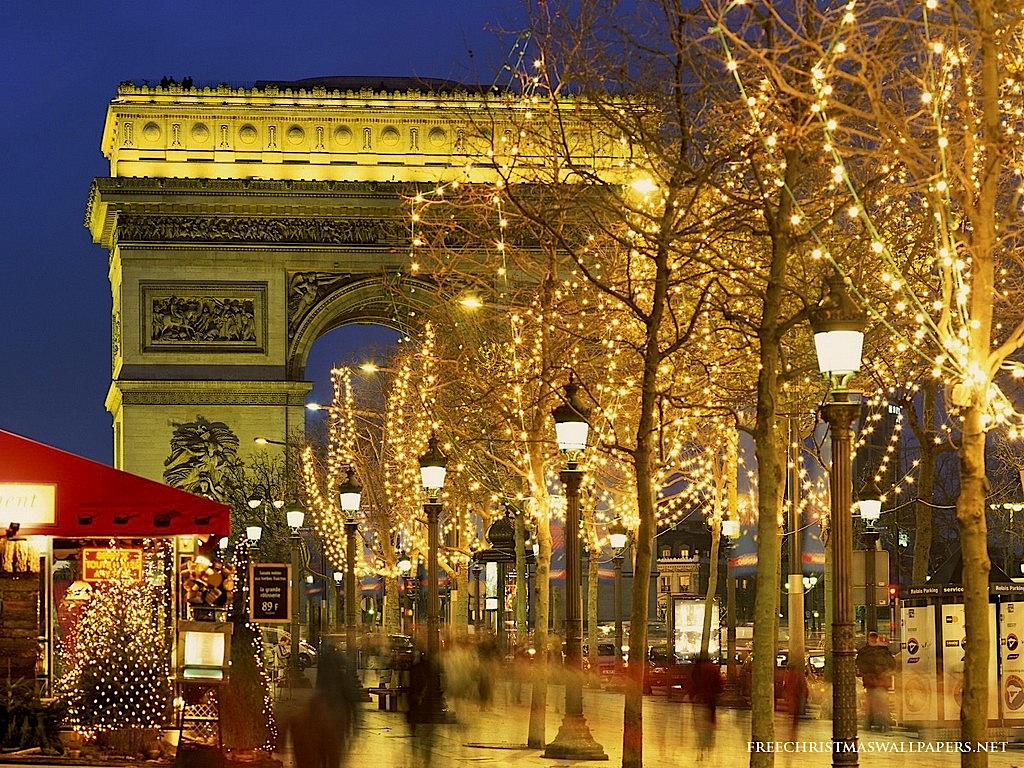MARIANI’SVirtual Gourmet
November 27,
2011
NEWSLETTER
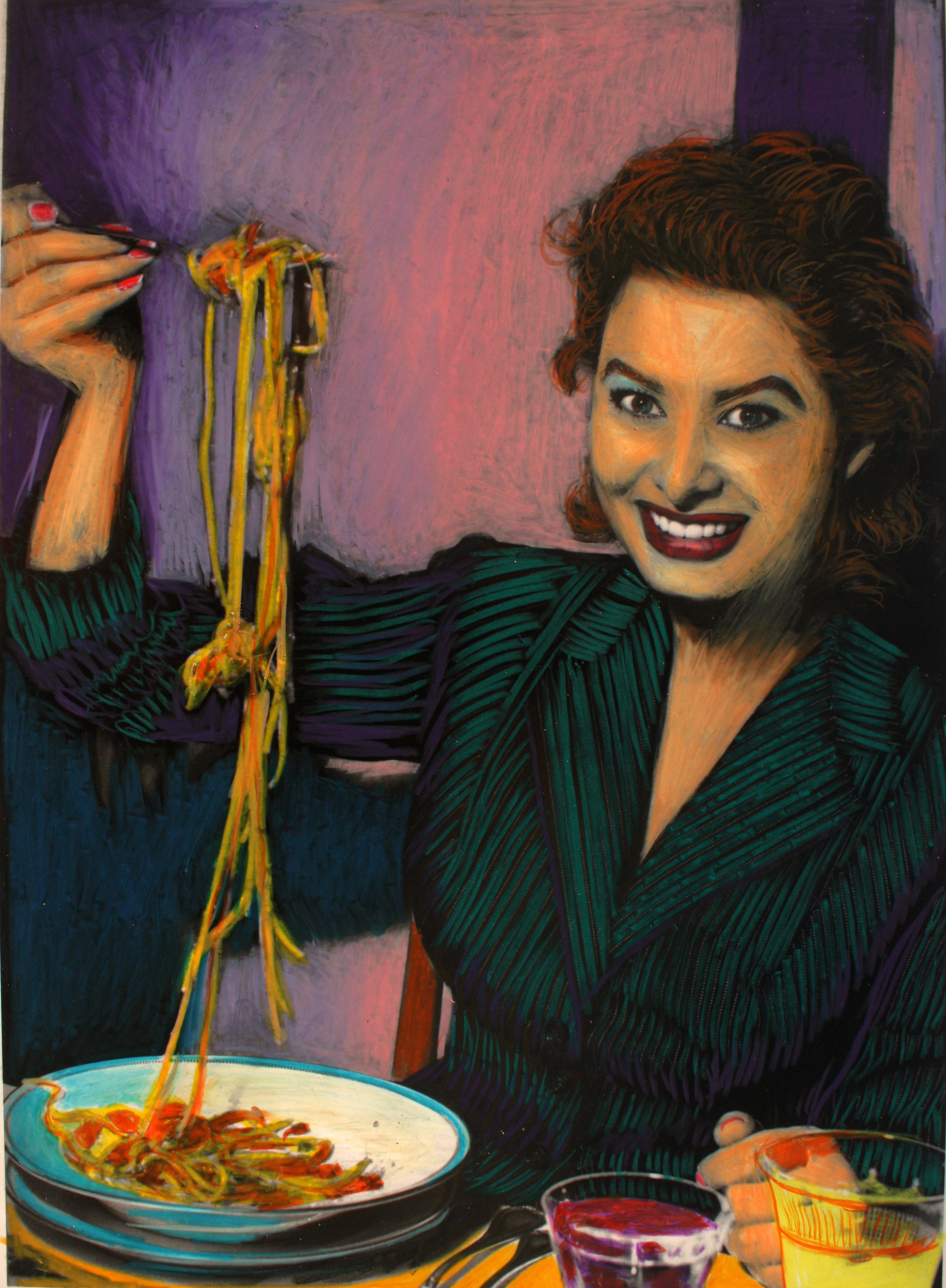
"Sophia," Hand-colored archival photo by Franc Palaia (2011)
THIS WEEK
HOLIDAY IN PARIS
by John Mariani
NEW YORK CORNER: MICHAEL'S, NEW YORK
by John Mariani
CAN THE 2009 BORDEAUX LIVE UP TO ALL THE HYPE?
by John Mariani
A fter New York and
London, no city celebrates Christmas with more spirit
than Paris, which, being the City of Lights, seems
wholly appropriate. The beauty of the city itself
gives it a festive cast year round, but during
Christmas and New Year's--especially given the
nightly, hourly light show that makes the Eiffel Tower
sparkle like a Christmas tree--Paris truly makes for a
joyeux Noël. If you're fortunate enough to
be there then--and don't mind spending a few euros for
the pleasure--here are some enchanting spots to stay
and dine. Consult the websites for any
special packages or prix fixe dinners.
Le Bristol
112 Rue du Faubourg St. Honoré
1-53-43-4300
www.lebristolparis.com
 Le
Bristol's Beaux Arts building dates back to 1757, before
the French Revolution turned the town topsy turvy, and
it has been a grand hotel since 1925. Closed for a
complete renovation and enlargement, the hotel has a new
wing, and it has retained every inch of its
classic architectural charm while showing a new polish
and, it seems, a youthful vitality among the
staff. Any whiff of Gallic snobbism has vanished.
Le
Bristol's Beaux Arts building dates back to 1757, before
the French Revolution turned the town topsy turvy, and
it has been a grand hotel since 1925. Closed for a
complete renovation and enlargement, the hotel has a new
wing, and it has retained every inch of its
classic architectural charm while showing a new polish
and, it seems, a youthful vitality among the
staff. Any whiff of Gallic snobbism has vanished.
The rooms are sunny, as much as possible by letting in the flood of the soft Parisian light that made the Impressionists giddy. The bathrooms are now California large and gorgeously appointed, marble from floor to ceiling, the amenities first rate. It would be hard to match the elegance and views of the Prestige Suite (left), and it's easy enough to see why the hotel is a favorite of the fashion crowd. (Le Bristol, incidentally, is renowned for its High Tea fashion shows.) It is one of the few grand palais hotels that also offers an extensive children's program and even a separate menu for them. And the lobby has its own roaming resident white cat named Fa-Raon who is much indulged by both staff and guests.
The hotel has its own florist, so there are vases of fresh flowers everywhere. There is a spa and very beautiful pool, business center, hair salon, and for a remarkable 10 euros you can rent a Bristol Smart Car to go shopping. (Just how many gift boxes fit into a Smart Car?)
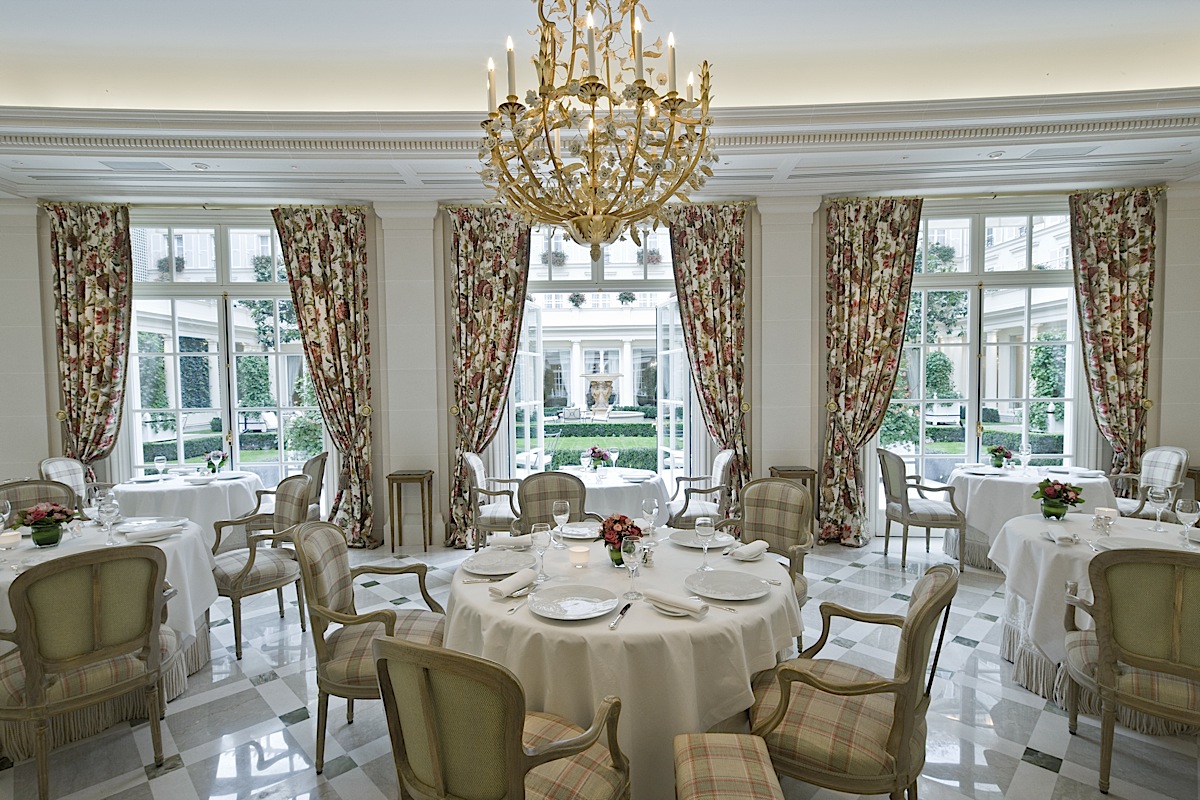
The biggest change here has been the relocation of the main Épicure dining room, which has had three Michelin stars for years now, to what had been the summer garden space. Now enclosed for year-round dining room, it is awash in sunlight, twilight and starlight through glass doors and windows. The old dining premises, where I most recently had an exceptionally fine lunch, is being turned into banquet facilities.
I cannot, then, speak of the new premises but I can easily rave about the quality of Chef Eric Frechon's cuisine, which now seems lighter and less complex than it used to be yet still solidly within haute cuisine standards of luxury. Instead of a seven-course extravaganza at lunch, I asked Frechon if he could serve each of us different three-course meals (we always switch plates), and of course he was far more generous than that, sending out exquisite amuses, breads, and tidbits to spur the appetite while we sipped Pierre Mouncuit Rosé Champagne. The amuses included foie gras lollipops with spun sugar and chips of crispy cheese and pistachios, with flavors and textures galore, the sweetness followed by the burst of cheese. There was also chorizo-studded egg custard, and an odd, small green ball that when placed on the tongue bursts with olive oil.
A creamy cauliflower mousseline in red onion gelée followed, with haddock foam--that last vestige of Ferran Adrià's culinary legacy--the kind of dish that exemplifies haute cuisine moderne, but without gimmickry. We both began with a succulent large langoustine and caviar, served cold, with crispy celeriac and a bit of Japanese lemon. Then came one of Frechon's signature dishes, macaroni stuffed with truffles, artichoke and foie gras (below)--the French are never one to skimp on expensive ingredients when it comes to pasta--which was slipped under the broiler with a topping of
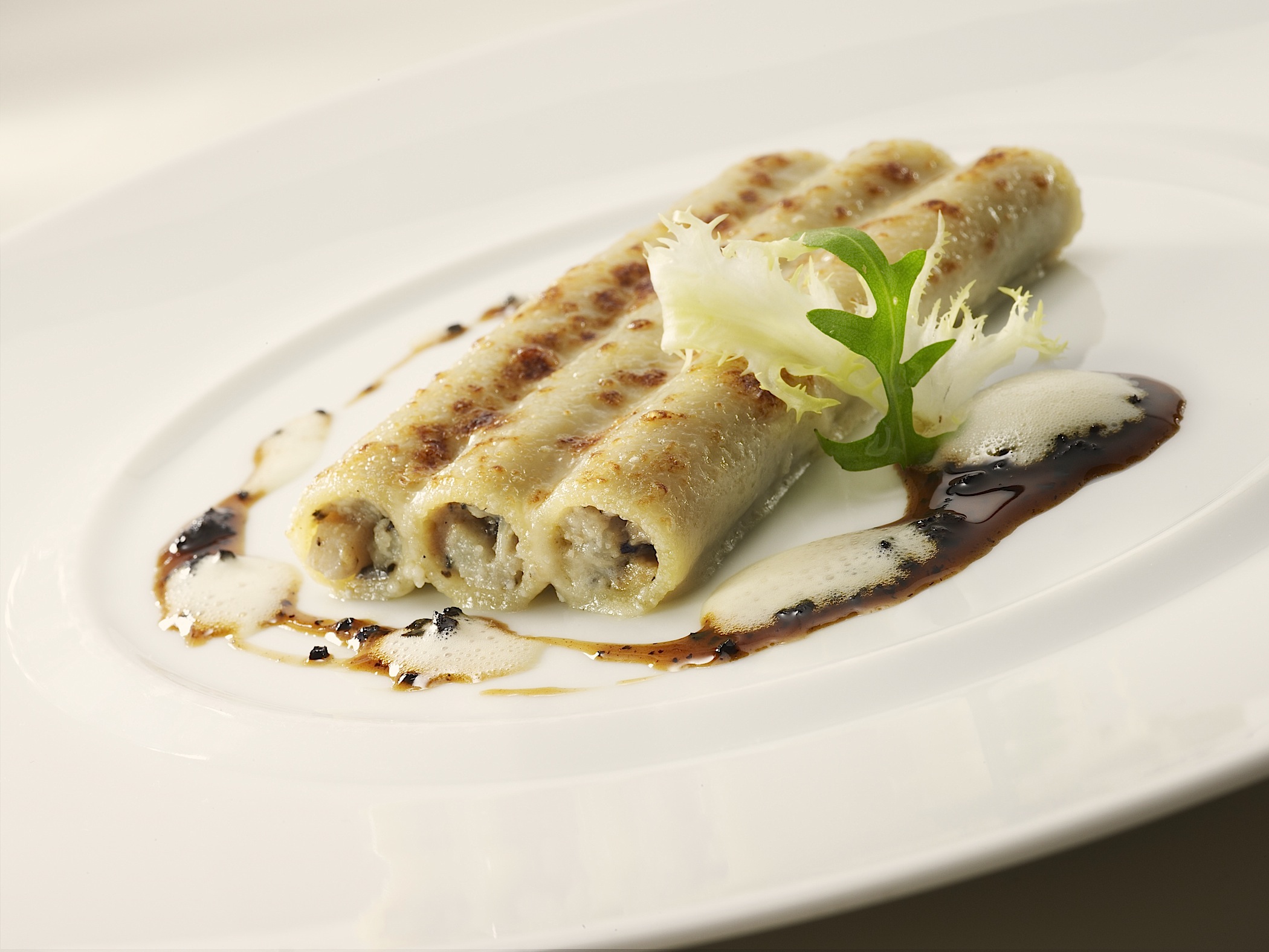 Parmigiano
cheese. With this we drank a Château
Dubois-Challon Fleur Amandine 2009, the marriage
decadent in the most honest ways. Veal sweetbreads
were braised with Amaretto, sweet red onions and candied
and fresh almonds to add texture. Although the
description sounds cloyingly sweet, this was an
outstanding, well-balanced dish, accompanied by a hearty
Château Barde-Haut 2000. The fish served was a
whiting in a bread crust with what was described as "al
dente" New Zealand spinach with curry oil, and it was
sensationally good, served with a perfectly mature
Domaine M. Colin Chassagne-Montrachet 2009. A lovely
selection of cheeses was matched with a Domaine Rolet
Père et Fils Arbois Vin Jaune 2004, while a
pre-dessert of a stalk of meringue with a sour citrus
sorbet, mango gelée, and mango powder was an
intense spark before black Provençal figs poached
in a spiced strawberry juice, with ice cream and
biscuits (plus numerous cookies, candies,
and chocolates), accompanied by sweet Domaine
Etko Commanderie Centurion from, of all places, Cyprus.
It was liquorous and delicious.
Parmigiano
cheese. With this we drank a Château
Dubois-Challon Fleur Amandine 2009, the marriage
decadent in the most honest ways. Veal sweetbreads
were braised with Amaretto, sweet red onions and candied
and fresh almonds to add texture. Although the
description sounds cloyingly sweet, this was an
outstanding, well-balanced dish, accompanied by a hearty
Château Barde-Haut 2000. The fish served was a
whiting in a bread crust with what was described as "al
dente" New Zealand spinach with curry oil, and it was
sensationally good, served with a perfectly mature
Domaine M. Colin Chassagne-Montrachet 2009. A lovely
selection of cheeses was matched with a Domaine Rolet
Père et Fils Arbois Vin Jaune 2004, while a
pre-dessert of a stalk of meringue with a sour citrus
sorbet, mango gelée, and mango powder was an
intense spark before black Provençal figs poached
in a spiced strawberry juice, with ice cream and
biscuits (plus numerous cookies, candies,
and chocolates), accompanied by sweet Domaine
Etko Commanderie Centurion from, of all places, Cyprus.
It was liquorous and delicious. This vast display of dishes was served in a very civilized two hours, and it is fascinating to watch the timing and tempo of the staff, the captain knowing precisely when to signal waiting waiters with their silver trays to bring the next course, the busboys always attendant to breads and removal of dishes. It was a flawless meal.
The restaurant has a cache of more than 30,000 bottles and a thousand selections. Menus are printed in various languages, and, of course, taxes and service are included in the price of the food. Dinner first courses run 78€-110€, main courses 62€-120€. A 6-course tasting menu runs 250€.
The Bristol is offering a Christmas package that includes a one-night stay, American Breakfast for two, a bottle of champagne and chocolates in your room upon arrival, and a special gift for children, from 650€. Christmas Réveillon dinner is 590€.
Hôtel
Fouquet's Barrière
Avenue George V & Champs-Élysée
1-140-696-059
www.fouquets-barriere.com
The Lucien BarriÉre Group's founder, François André, dreamed of owning Fouquet's restaurant as long ago as the 1920s, and his nephew Lucien went on to build on his uncle's legacy of grand hotels, with the Group eventually owning and operating 40 casinos, 16 hotels and more than 90 restaurants. But the famous Fouquet's (once a coachmen's inn and the first restaurant to open on the Champs Élysée) eluded them. Intimately bound to the history of French and international cinema, from which the Molière and César Awards Ceremonies were launched, Fouquet's was also the place during World War I where the French flier aces drank when not shooting down German biplanes and zeppelins. The restaurants had a good run until the 1970s, when, like the Champs Élysee itself, it went into decline. A new owner tried to revive it but it took three years of legal battles and the award of Historic Landmark status to prevent Fouquet's from being shuttered by the landlord. In the fall of 1998, with the Champs Élysée now chic with expensive fashion stores, the Barrière Group took it over and began its renovation, with the new hotel opening in 2006.
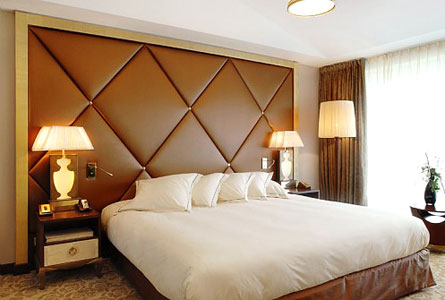 The Group
describes the new décor as "modern yet baroque,"
with plenty of posh appointments throughout, including
an open-air terrace and beautiful interior
garden, with every room offering views of the Champs
Élysée or George V. Velvet and
damask are used in the curtains and canopies,
gold-leafed arches and columns are everywhere, and
the bathrooms are among the most spacious in Paris, with
black granite floors and walls, double sinks and TV
screens. Soft drinks from the mini bar are
complimentary, as is an internet connection--which I
hope becomes the norm in at a time when other hotels in
Paris charge exorbitant rates for such an amenity. There
is, of course, a completely modern U Spa and a 50 by 26
foot swimming pool.
The Group
describes the new décor as "modern yet baroque,"
with plenty of posh appointments throughout, including
an open-air terrace and beautiful interior
garden, with every room offering views of the Champs
Élysée or George V. Velvet and
damask are used in the curtains and canopies,
gold-leafed arches and columns are everywhere, and
the bathrooms are among the most spacious in Paris, with
black granite floors and walls, double sinks and TV
screens. Soft drinks from the mini bar are
complimentary, as is an internet connection--which I
hope becomes the norm in at a time when other hotels in
Paris charge exorbitant rates for such an amenity. There
is, of course, a completely modern U Spa and a 50 by 26
foot swimming pool. The 40-seat restaurant within the hotel is called Le Diane (below), after one of the Barrière family, opening onto that lovely garden patio. It's all about light here, quite modern, with gold and mauve contrasted with orange and sprays of the season's flowers. The silverware is Christofle, the china Limoges, the glassware crystal. Here Chef Jean-Yves Leuranguer makes a modern cuisine tending towards a lighter spirit, with dishes like tomato tart with burrata; Challans duck with a turnip confit spiced with orange and ginger; mullet with zucchini flowers, olive oil, and sauce vierge; pressed quail with foie gras and chutney; and wild strawberries with vanilla cream and almond croustillant and rhubarb sorbet. His cooking is very much centered on the main ingredient, not distracted by so many others, and the pedigree of those ingredients--Challan duck, Charolais beef, and more--is unassailable.
Le Diane is open for breakfast, lunch and dinner, and Chef Leuranguer offers tasting menus at 78€, 98€ and 125€. À la carte appetizers run 29€-59€ and main courses 42€-66€, which these days in Paris constitute moderate prices for this caliber of cuisine. Le Diane is also featuring a Christmas dinner as part of a Le Diane package that includes a luxury room or suite, American breakfast for two, dinner at Le Diane, complimentary pass to the spa, and more.
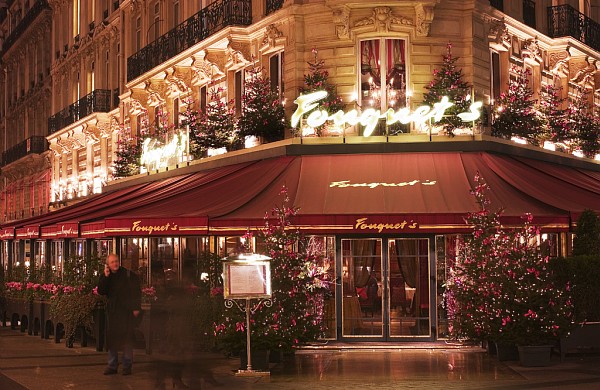 I did not have time to
dine at Fouquet's but I was enchanted at least to
have breakfast there. While retaining a look
that partakes of its Belle Epoque history, it is
wonderfully bright and shiny, and its prospect on
the Champs Élysée and Avenue Georges V
is nonpareil. One need not try too hard to
imagine everyone from Jean Gabin and Romy Schneider
to Audrey Hepburn and Cary Grant sitting at a table
here, and although it's often regarded as a
brasserie, the dining rooms (one upstairs) are quite
elegant, with crystal chandeliers, leather
banquettes, thick carpeting, and mahogany accents,
with scores of black and white photos of the
celebrities who have filled its tables.
I did not have time to
dine at Fouquet's but I was enchanted at least to
have breakfast there. While retaining a look
that partakes of its Belle Epoque history, it is
wonderfully bright and shiny, and its prospect on
the Champs Élysée and Avenue Georges V
is nonpareil. One need not try too hard to
imagine everyone from Jean Gabin and Romy Schneider
to Audrey Hepburn and Cary Grant sitting at a table
here, and although it's often regarded as a
brasserie, the dining rooms (one upstairs) are quite
elegant, with crystal chandeliers, leather
banquettes, thick carpeting, and mahogany accents,
with scores of black and white photos of the
celebrities who have filled its tables. Chef Leuranguer oversees the kitchen here, too, and the menu is considerably more traditional than at Le Diane, with starters (27€-49€) like lobster in fennel soup, parsnip soup with foie gras; and smoked salmon with potato puree; and main courses (48€-64€) like John Dory a la nage with coco beans and mizuna; roast rack of lamb with vegetable tian; and sautéed sole with steamed potatoes.
There is a menu at 89€. The restaurant is open for breakfast, lunch and dinner.
La Cuisine
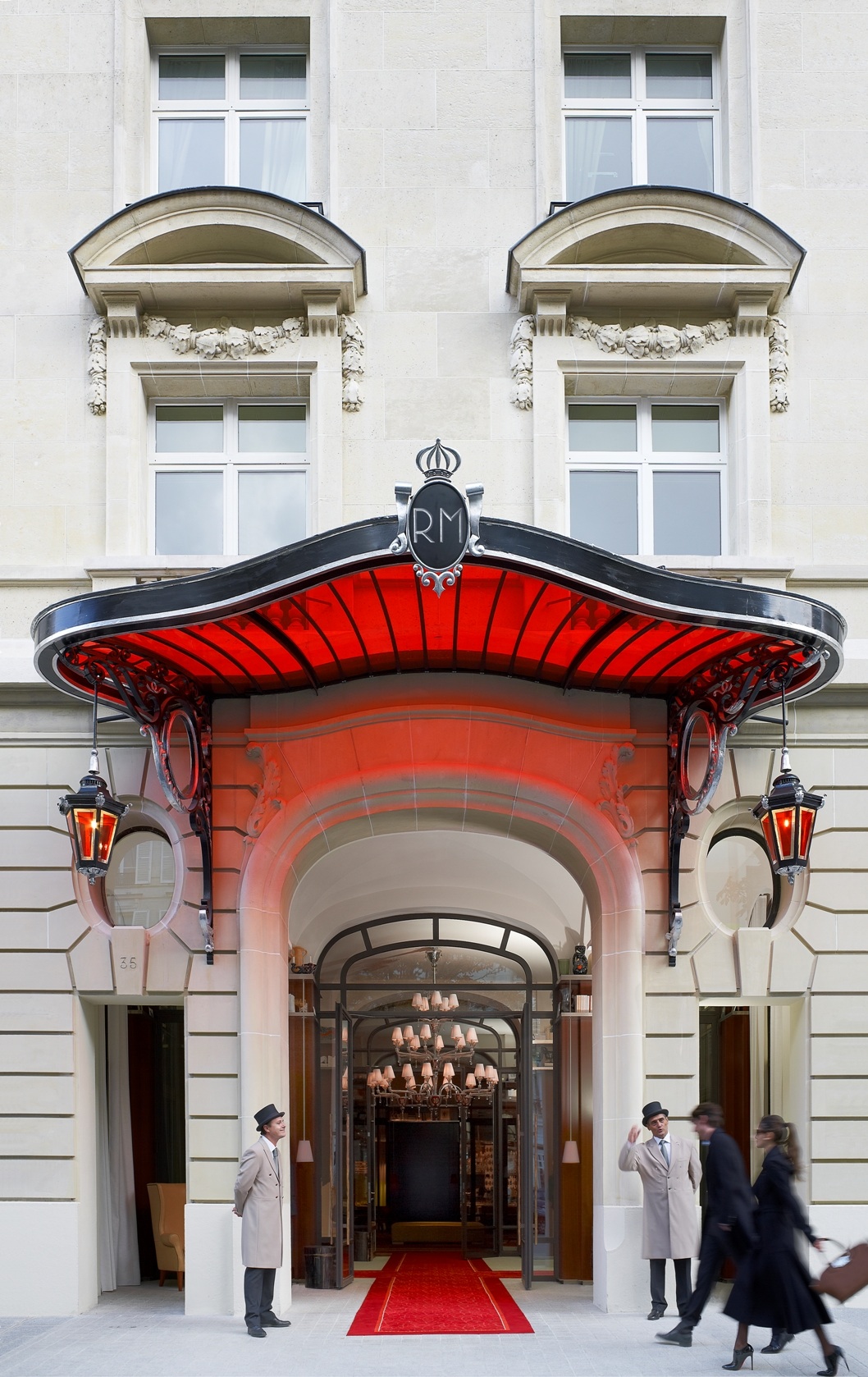
Le Royal Monceau Raffles
24 Avenue Hoche
1-42-99-9865
www.leroyalmonceau.com
There are two restaurants at the new Royal Monceau, one indelibly French, called La Cuisine, the other stylishly Italian, named Il Carpaccio. I reported on both some months ago, but I happily had occasion to return to La Cuisine this fall to see how the seasons were changing the menu there, under Executive chef Laurent André and chef de cuisine Gabriel Gapin, who focus is on ingredients rather than presentation. There is an emphasis on roasting and grilling without fuss.
I am also happy to report that prices here are somewhat below those at other deluxe hotel dining rooms in Paris, with appetizers from 22€ to 41€, main courses 39€ to 55€, a seafood prix fixe dinner at 90€ and vegetarian menu at 39€. There is a communal table (below) with aluminum chairs, the open kitchen faces the dining room.
You might begin with medallions of Brittany lobster come with a vegetable salad and a silky mushroom marmalade. There is the inevitable pasta dish, one night done with lobsters and sweetbreads, a rich, wonderful dish, or the more traditional Parisian gnocchi, piped from a pastry tube, were rife with peas, wild mushrooms and a julienne of ham; currently Burgundian snails are added. Chestnut soup, perfect for the season, comes with guinea fowl meat on toast, while duck foie gras is roasted till its center is creamy and pink, served with fresh fig and black pepper caramel.
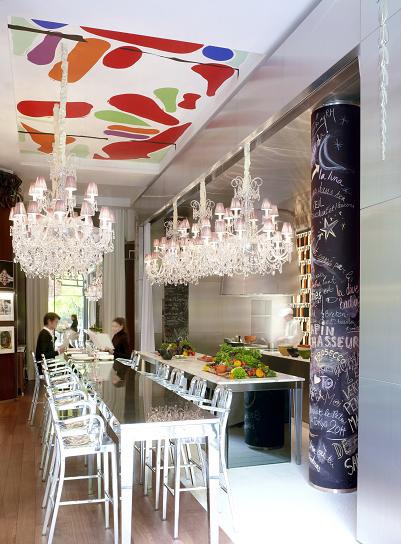 Sea
bass is roasted on a spit (not easy to get right and
keep intact), and accompanied by polenta, black olives
and dried tomato coulis. Also from the spit cames
browned, succulent squab à la "Rossini,"
with foie gras and truffles. There is even a selection
of sushi here, like razor clam with golden caviar, as
well as a cold shellfish consommé.
Sea
bass is roasted on a spit (not easy to get right and
keep intact), and accompanied by polenta, black olives
and dried tomato coulis. Also from the spit cames
browned, succulent squab à la "Rossini,"
with foie gras and truffles. There is even a selection
of sushi here, like razor clam with golden caviar, as
well as a cold shellfish consommé. It is very difficult these days to justify ordering both cheese and dessert, so go with someone willing to share both. We were delighted by the variety of perfectly ripe cheeses, breads, and condiments (14€), no less than the exquisite desserts that includes a delicate rendering of millefeuille pastries. The montebello dessert is a pistachio dacquoise biscuit with pistachio mousseline cream, and seasonal berries. There is also a citron tart with lemon cream and candied lemon, and an entire page devoted to macarons, which have become the sweet rage of the moment in Paris.
The 35,000 bottle wine list, overseen by Burgundian sommelier Manuel Peyrondet, is very strong for a young restaurant and growing; prices are haute reasonable, with some good wines under 60€.
The big, spacious room itself bright but softly lighted, with crystal chandeliers and 1960s mod colors throughout, reds, blues, yellows, with graffiti-like messages on columns; it's a great spot for people watching, especially since the hotel has actively courted a show biz crowd, so that some rooms are named after great performers, like Ray Charles, and the hotel has its own cinema room with 100 seats.
The rooms at the Royal Monceau have been designed to feel more like apartments in their appointments, with particular books and décor resembling a (well-off) artist's atelier. Le Royal Monceau is very much the hotel of the moment, and given its forward-looking decor and breezy public spaces, it is likely to be so for a good long time to come.
Les Tablettes
16 Avenue Bugeaud
1-56-28-1616
www.lestablettesjeanlouisnomicos.com
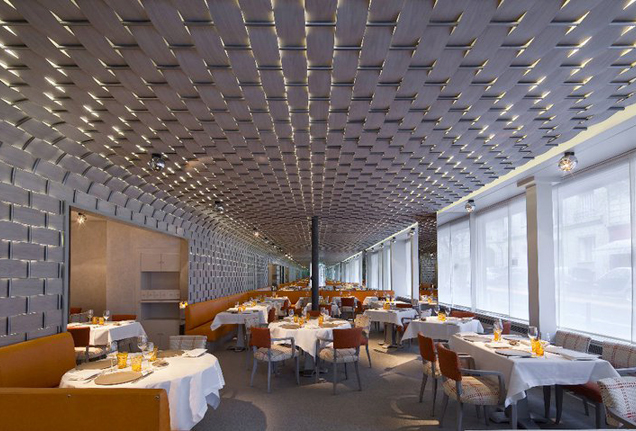 Jean-Louis
Nomicos, formerly of Laserre and Alain Ducasse, brings
his own modern French cuisine to this new casually
chic restaurant near the Arc de Triomphe, with a sleek
slender dining room with gray basketweave
wallcoverings and burnt orange fabrics. Its size
and menu scope is a pretty good indication of the
style of 21st century free-standing restaurants in the
city now, for few individuals, without massive
financial support from a hotel or luxury goods
company, can any longer launch the kind of restaurant
that garners three Michelin stars--despite Michelin's
hollow boast that they only judge what's on the plate,
never the plate itself.
Jean-Louis
Nomicos, formerly of Laserre and Alain Ducasse, brings
his own modern French cuisine to this new casually
chic restaurant near the Arc de Triomphe, with a sleek
slender dining room with gray basketweave
wallcoverings and burnt orange fabrics. Its size
and menu scope is a pretty good indication of the
style of 21st century free-standing restaurants in the
city now, for few individuals, without massive
financial support from a hotel or luxury goods
company, can any longer launch the kind of restaurant
that garners three Michelin stars--despite Michelin's
hollow boast that they only judge what's on the plate,
never the plate itself.
The menu here has a sensible number
of dishes, and we began with a delicious shooter of
foamy mushroom soup. Our guest ordered what
turned out to be a simply wondrous dish--poached egg
with girolles,
a "chlorophylle"
of parsley, and emulsion of truffles and potato, a
very good wintry dish. "Papillons"-shaped pasta (farfalle in
Italy) came with clams, squid, shrimp and a
little basil, needing more flavorful components, not
least garlic and oil.
Sweetbreads came with a gremolata (note
the ubiquitous influence of Italian cuisine in Paris
these days!), poppyseeds, and citron honey, a superb
dish, deceptively simple, with the essential flavors
all enhancing each other. Also very good were tender
veal cheeks with citron caviar, romaine lettuce, and
gnocchi. Noisettes
of lamb had plenty of flavor, especially accompanied
by eggplant, pine nuts, zucchini and savory.
The desserts stay simple,
too, from warm figs with rosemary, honey, and almond
ice cream to a chocolate "grand cru," three items on
one plate, moelleux,
fondant, and café emulsion, ending off with mignardises,
lemon tart and hazelnut cream.
Appetizers run 29€ to 48€, main
courses 26€-59€, with dégustations at 80€, 120€
and 145€, which includes two glasses of wine. For
Christmas there is a seven-course 160€ meal with a
glass of vintage Champagne.
The wine list is good
for this size restaurant, though there is next to
nothing on it under 50€, which is unfortunate.
NEW
YORK CORNER
MICHAEL'S, New York
24 West 55th Street (near Fifth Avenue)
212-767-0555
www.michaelsnewyork.com
In1979, at the age of
25, the redoubtable Michael McCarty opened his
namesake restaurant in Santa Monica, CA, then
quite off the beaten track of Los Angeles' dining
map. Aside from the Italian restaurant
Valentino, there wasn't much out there except the
beach, so to add a true fine dining spot to the
neighborhood took a leap of personal faith.
Fortunately, McCarty, originally from the NY suburb of
Briarcliff, had self-esteem and youthful exuberance to
burn, and his own culinary experience up till then was
impressive: He lived
in the Champagne region of Rennes for a year as part
of the Andover-Exeter School Year Abroad program,
where he fell hard for fine French cuisine and
service, going on to study cooking, wines, and hotel
and restaurant management in Paris, earning diplomas
from the École Hôteliére de Paris,
the Cordon Bleu, and the Academy du Vin. In 1974, he
returned to the United States, attended Cornell's
Summer Hotel Program, and earned a Bachelor of Arts in
the Business and Art of Gastronomy from the University
of Colorado at Boulder.
Michael's was unlike any other restaurant of its day,
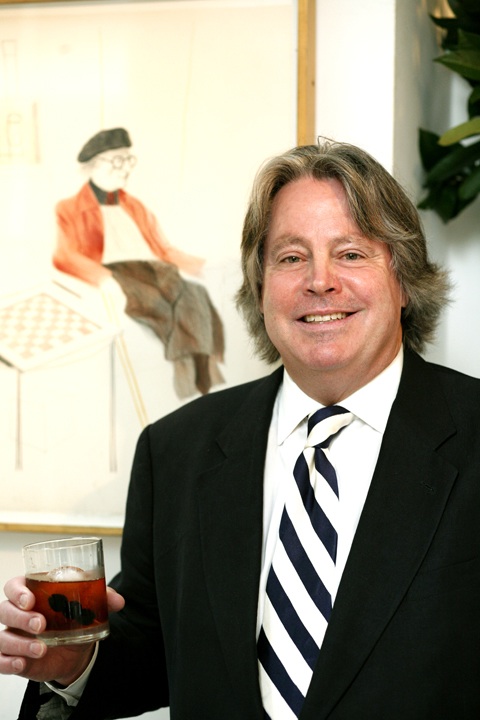 for while it was in the
vanguard of what was being called "New California
Cuisine," the restaurant had a breezy American style
to it, replete with some of the emerging American
artists' paintings and sculptures decorating the room,
including Jim Dine and David Hockney, which his wife,
painter Kim, helped him to collect. The patio was pure
California casual chic, with white umbrellas, daisies
in the Perrier bottles, and an engaging crew of
waiters dressed in khakis, pink Oxford shirts and knit
ties. All that, and wonderful French-California
cuisine--those first menus were entirely in
French--was engagingly new, and long before the word
"locavore" was coined, McCarty, along with other L.A.
progenitors were cooking with only the finest,
freshest ingredients available from the California
cornucopia. At the beginning, McCarty was the menu
creator but along the way he had a notable number of
young talents, like Jonathan Waxman, to oversee the
kitchen.
for while it was in the
vanguard of what was being called "New California
Cuisine," the restaurant had a breezy American style
to it, replete with some of the emerging American
artists' paintings and sculptures decorating the room,
including Jim Dine and David Hockney, which his wife,
painter Kim, helped him to collect. The patio was pure
California casual chic, with white umbrellas, daisies
in the Perrier bottles, and an engaging crew of
waiters dressed in khakis, pink Oxford shirts and knit
ties. All that, and wonderful French-California
cuisine--those first menus were entirely in
French--was engagingly new, and long before the word
"locavore" was coined, McCarty, along with other L.A.
progenitors were cooking with only the finest,
freshest ingredients available from the California
cornucopia. At the beginning, McCarty was the menu
creator but along the way he had a notable number of
young talents, like Jonathan Waxman, to oversee the
kitchen.
 So inextricable
did Michael's seem from the California ethos, that it
was with some surprise that he opened an outpost,
looking much like the original, on New York's west
side, in 1989. From the start McCarty (right) won over a
whole new crowd--he'd be in each city twice a
month--not least among New York's expense account-rich
media--while attracting regulars from California who
came to town for some TLC and McCarty cuisine. They
would come for a power breakfast, lunch or dinner,
happy to see McCarty, never sure how long his hair
would be or how broad his jacket's shoulders, but they
could usually count on him wearing faux-leopard
spotted shoes.
So inextricable
did Michael's seem from the California ethos, that it
was with some surprise that he opened an outpost,
looking much like the original, on New York's west
side, in 1989. From the start McCarty (right) won over a
whole new crowd--he'd be in each city twice a
month--not least among New York's expense account-rich
media--while attracting regulars from California who
came to town for some TLC and McCarty cuisine. They
would come for a power breakfast, lunch or dinner,
happy to see McCarty, never sure how long his hair
would be or how broad his jacket's shoulders, but they
could usually count on him wearing faux-leopard
spotted shoes.
In all those years since,
McCarty and his chefs (currently Kyung Up Lim) have
never veered much from the original menu
concepts--plenty of effulgent salads, baby lamb, Dover
sole, and freshly baked cookies, still basing
everything on the season and the ingredients.
The waiters still wear chinos and Oxford shirts, and
though McCarty has retired the leopard shoes (I
think), he still beams with California exuberance and
swagger and seems on a first name basis with most of
his guests. He even serves wines from his own,
admirable Malibu vineyards, along with 800 other
labels.
Except for a brief lunch, I hadn't
been back to Michael's for a long time, so I was very
happy to find him at the restaurant. I've known him
since he opened the original Michael's so I spent a
few moments reminiscing about how things have both 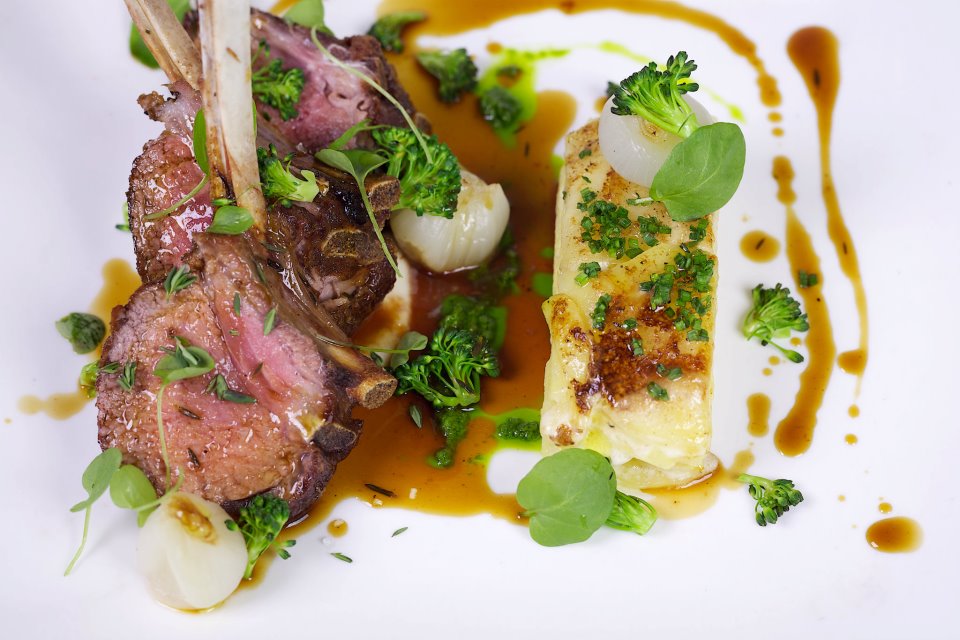 changed and not changed. Michael's
longevity as a restaurant suggests that consistency
and dedication will always outlast the faddish and
cutting edge, the former also passing, the latter
always becoming dull.
changed and not changed. Michael's
longevity as a restaurant suggests that consistency
and dedication will always outlast the faddish and
cutting edge, the former also passing, the latter
always becoming dull.
The place looks great, but is it my
imagination the lights are lower than they used to
be?, which takes a little of the fun out of a dining
room. It was a fairly quiet night, and we took our
time, ordering from a new array of cocktails, some
interesting, some odd, and perusing the winelist
before going with a 2009 Belicard Puligny Montrachet
and a 2007 Malibu Pinot Noir. Our
first courses included an item I am helpless to
refuse--Florida stone crabs, those fat, meaty
appendages that need nothing more than a dip in
mustard sauce or mayo. Sweet potato and mascarpone
packed tender ravioli, served with a simply and very
well rendered beurre noisette, tinged with sage and
crushed hazelnuts for added texture. An heirloom
carrot salad was exemplary of the Michael's style,
full of fennel,
arugula, marjoram, goat's cheese, and pepitas.
As with those stone claws, I could
hardly turn down a mid-course of the season's first
bay scallops, accompanied by small mussels,
shaved ice radishes, and leaves of
Brussels sprouts (above).
Our main courses included a
perfect, plump Dover sole, grilled with a meunière
butter sauce on the side; luscious skate wing that had
been breaded and quickly sautéed just past
translucence and served with leeks, celery root, and
seafood salad; and an Ellensburg rack of lamb (above), well
fatted and a kind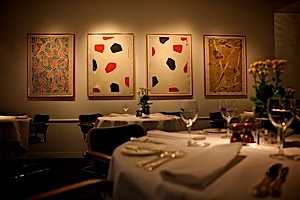 of signature dish at
Michael's, accompanied by a succulent potato gratin,
cipollini, broccoli ans the pan juices.
of signature dish at
Michael's, accompanied by a succulent potato gratin,
cipollini, broccoli ans the pan juices.
Desserts
in profusion, by Brooklyn girl Diane Carrasquillo,
included the anticipated cookies, exceptionally rich dulce de leche
cake with a sprightly citrus icing; a moist pumpkin
bread pudding with candied pumpkin seeds and cinnamon
ice cream; chocolate cake with white chocolate mousse
and pistachio-cranberry ice cream; and peanut
butter cheesecake with a chocolate ganache; upside
down fig cake, seasonal sorbets and ice creams, along
with meringues, coconut macaroons, classic
chocolate chips, and double-chocolate cookies. Great
place for the holidays.
Scroll back over this menu we
had and you'll see that the ideas have become American
classics in style and flavors, these days taken for
granted by young cooks everywhere. But those
young cooks should realize that without Michael's and
without McCarty and his colleagues from those exciting
days three decades ago, little of this would be on
menus today. And rarely with such personal
panache.
Jasper Johns, Untitled,
1981.
❖❖❖

MAN ABOUT TOWN
by Christopher Mariani
The Man About Town is on assignment.
His column will appear in an upcoming issue.
Here
we go again.
We’re only 12 years into the 21st
century and yet another Bordeaux vintage, 2009, is
being declared the “vintage of the century” by the
wine industry and media, which said the same thing
about the 2005 vintage. And word is that those who
have tasted barrel samples of 2010 are combing the
thesaurus for even more superlatives.
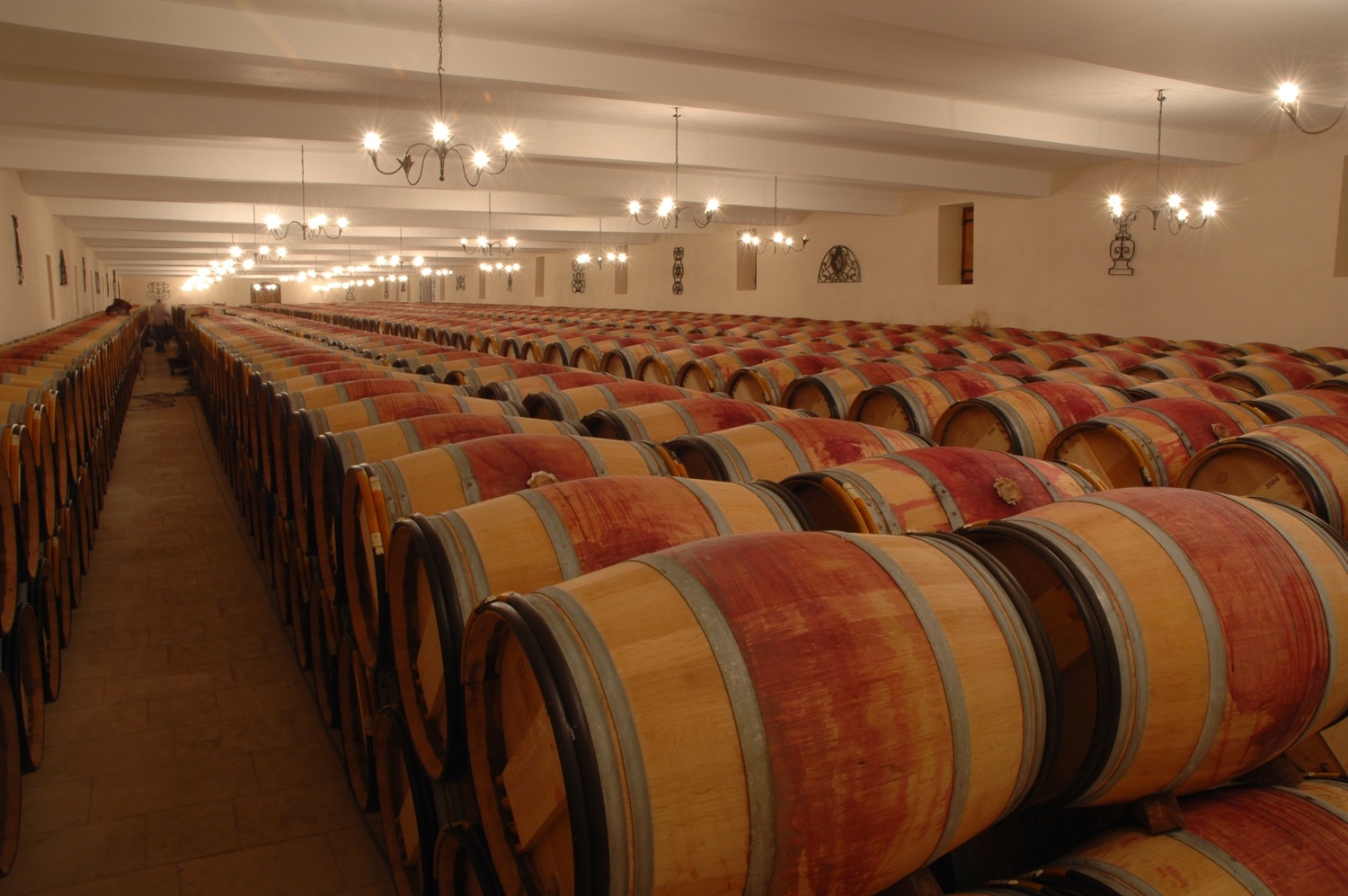 Words
like “spectacular,” “awesome” and “magnificent” have
been bandied about thus far—and the wines will not
even be in stores till next spring or summer.
Hyperbolic wine guru Robert Parker, who tasted the
wines in barrel, has even declared that “For some
Médocs and Graves, 2009 may turn out to be the
finest vintage I have tasted in 32 years of covering
Bordeaux.”
Words
like “spectacular,” “awesome” and “magnificent” have
been bandied about thus far—and the wines will not
even be in stores till next spring or summer.
Hyperbolic wine guru Robert Parker, who tasted the
wines in barrel, has even declared that “For some
Médocs and Graves, 2009 may turn out to be the
finest vintage I have tasted in 32 years of covering
Bordeaux.”
With Bordeaux wine prices already
at an all-time high—-even the mediocre 2006 and 2007s
vintages were very expensive--Bloomberg’s Elin McCoy
last year reported that upon offering futures for the
2009 London wine merchant Berry Bros. & Rudd sold
700 cases in one hour, with online orders freezing up
their computers.
Unlike some of my colleagues who exalted the
2009s after tasting them in barrel more than a year
ago, I have been content to wait until the wines have
been bottled and aged.
Having tasted many prestigious wines in barrel
over the years, the one thing I discovered is that the
wine in one barrel can differ considerably from that
in barrel next to it.
Unless you work at a Bordeaux château and
can monitor all the wines in every barrel from the
beginning, finished wines are a much more sensible way
to judge a vintage’s character.
I was therefore delighted to attend the
sold-out annual Fête du Bordeaux at The Four
Seasons restaurant (below)
in New York in October, where six examples of the 2009
vintage were tasted. Restaurant owners Alex von Bidder
and Julian Niccolini brought in three notable Bordeaux
vignerons, Anthony Barton of Châteaux
Léoville Barton and Langoa Barton (above),
Jean-Charles Cazes of Châteaux Lynch-Bages and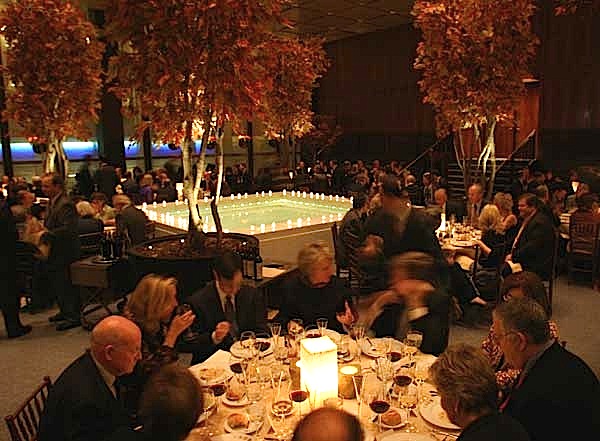 Ormes de Pez, and Nicholas
Glumineau of Châteaux Montrose and Tronquoy
Lalande.
Ormes de Pez, and Nicholas
Glumineau of Châteaux Montrose and Tronquoy
Lalande.
Glumineux was so giddy
about the vintage that he got up and sang an Italian
aria and “New York New York” before declaring that the
wines are “so powerful, so long, so expressive, as if
I’m talking about the woman I love.” French guys tend
to do that. (A video
exists of Mr. G not resisting his urge to sing in
public.)
At my table of winelovers, which included one
Master of Wine and one from the trade, opinion
differed on the 2009s, though no one went into any
fits of ecstasy over them. My own reaction was that
this is indeed a very good vintage but one that also
says a lot about how Bordeaux wines have changed over
the past decade.
None was a First Growth—no Lafite, no Margaux,
no Haut-Brion or the rest—but they were all fine
examples, including newly emergent estates like
Château Tronquoy Lalande, which recently
underwent a three-year, 10 million euro rehab. Overall I
found every wine surprisingly voluptuous—even at only
13 or 13.5 percent alcohol--very fruity, with tannins
already quite softened and not as much acid as I’d
hoped for. My
notes
contain words like “huge,” “thick,” even the
occasional “wow,” and I would happily drink any of
them right now rather than wait five to ten years to
see how they develop. I thought the Tronquoy Lalande
had exceptional depth and laudable tannins, with a
bouquet that took a little while to open up. Les Ormes
de Pez, a cru bourgeois, was actually sweet on the
finish, with a caramel and oddly vegetal nose that
blossomed quickly in the glass.
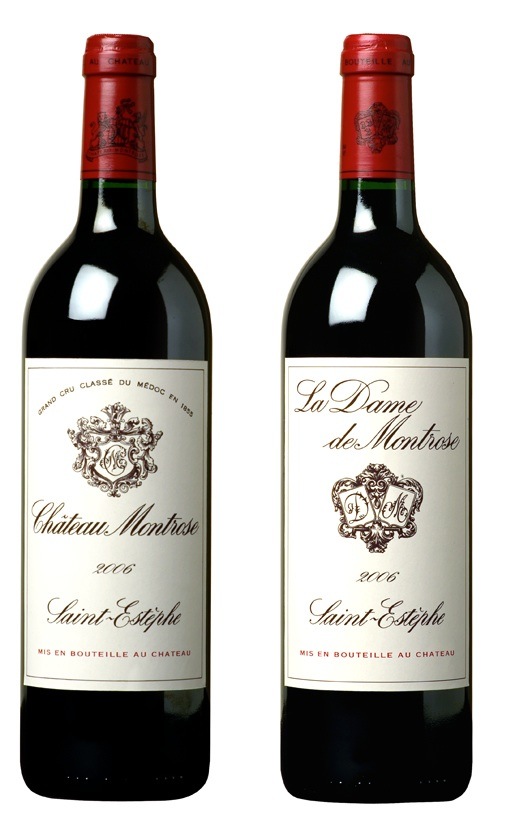 Château
Langoa
Barton, a 3rd
Growth from Saint-Julien, was, as expected, closer to
the usual Bordeaux taste of restrained fruit and good
mineral notes, though it seemed far forward. Lynch-Bages,
a 5th Growth
from Pauillac, was tight at first but opened up to
reveal elegance very much in the Bordeaux tradition,
while Leoville-Barton was also tight and somewhat
tannic, but there was a refinement here I’d expect
from the 2nd
Growth Saint-Julien. This one has a bright, long
future.
Château
Langoa
Barton, a 3rd
Growth from Saint-Julien, was, as expected, closer to
the usual Bordeaux taste of restrained fruit and good
mineral notes, though it seemed far forward. Lynch-Bages,
a 5th Growth
from Pauillac, was tight at first but opened up to
reveal elegance very much in the Bordeaux tradition,
while Leoville-Barton was also tight and somewhat
tannic, but there was a refinement here I’d expect
from the 2nd
Growth Saint-Julien. This one has a bright, long
future.
Montrose (left),
a
2nd Growth
Saint-Estephe, was very thick, very bold, and held on
to its big tannins; I’d keep these around for a while.
I was
very happy with the wines, though I’ll hold my
exhilaration at bay thus far. My concern is implicit
in my scribbled note that “the 2009s taste like really
good California cabernet blends,” which is a
backhanded way of saying that California blends are
becoming more complex but that Bordeaux winemakers,
already troubled by global warming, may be making
their wines in a far bigger, more forward—dare I say,
overripe—style that tends to impress the critics. This
is not your father’s Bordeaux.
In the end, though, does it really matter? The
global market, fueled by Chinese, is buying up all the
classified Bordeaux it can find, in good and weak
vintages. And
with First Growth 2009s selling for thousands and
lesser chateaux selling for hundred per bottle,
craziness, not connoisseurship, makes yet another
“vintage of the century” pretty much a moot
point.
John Mariani's wine column appears in Bloomberg Muse News, from which this story was adapted. Bloomberg News covers Culture from art, books, and theater to wine, travel, and food on a daily basis.
❖❖❖
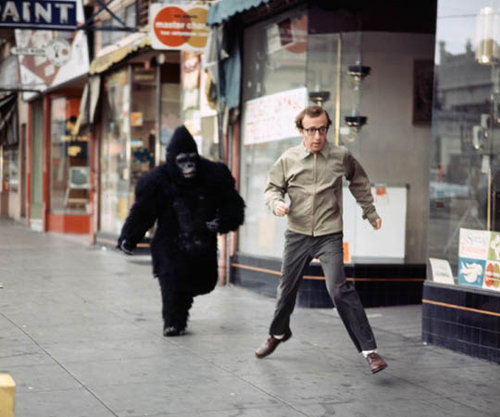 WHAT
IS
IT ABOUT TACOS THAT
WHAT
IS
IT ABOUT TACOS THAT BRINGS OUT THE BEAST IN MEN?
A man in Georgia, dissatisfied with the filling in his food bought at Taco Bell, returned at four AM and tried to throw a Molotov cocktail though the drive-thru window but missed, hitting only the building. . . Meanwhile, in San Diego, a man ordered a burrito at a taco stand to distract attention from his accomplice, who was dressed in a gorilla mask, trying to rob the place.
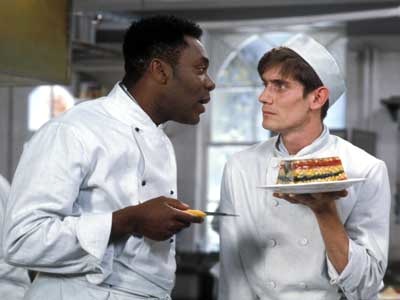 . . . NOT TO MENTION THE
WAY CHEFS REACT TO AA GILL
. . . NOT TO MENTION THE
WAY CHEFS REACT TO AA GILLAfter
reading
a negative review by critic AA Gill in the Sunday Times,
Chef Charlie McCubbin from the River Cafe, Brecon,
allegedly swung a
punch at kitchen worker Keith McVaigh, then pushed
him downstairs and tussled with him. He also
allegedly used "foul" language and "appeared
intoxicated."
Any of John Mariani's
books below may be ordered from amazon.com.
 |
My latest book, written with Jim Heimann and Steven Heller, Menu Design in America, 1850-1985 (Taschen Books), has just appeared, with nearly 1,000 beautiful, historic, hilarious, sometimes shocking menus dating back to before the Civil War and going through the Gilded Age, the Jazz Age, the Depression, the nightclub era of the 1930s and 1940s, the Space Age era, and the age when menus were a form of advertising in innovative explosions of color and modern design. The book is a chronicle of changing tastes and mores and says as much about America as about its food and drink.
“Luxuriating vicariously in the pleasures of this book. . . you can’t help but become hungry. . .for the food of course, but also for something more: the bygone days of our country’s splendidly rich and complex past. Epicureans of both good food and artful design will do well to make it their cofee table’s main course.”—Chip Kidd, Wall Street Journal.
“[The menus] reflect the amazing craftsmanship that many restaurants applied to their bills of fare, and suggest that today’s restaurateurs could learn a lot from their predecessors.”—Rebecca Marx, The Village Voice. |
"Eating Italian will never be the same after reading John Mariani's entertaining and savory gastronomical history of the cuisine of Italy and how it won over appetites worldwide. . . . This book is such a tasteful narrative that it will literally make you hungry for Italian food and arouse your appetite for gastronomical history."--Don Oldenburg, USA Today. "Italian
restaurants--some good, some glitzy--far
outnumber their French rivals. Many of
these establishments are zestfully described
in How Italian Food Conquered the World, an
entertaining and fact-filled chronicle by
food-and-wine correspondent John F.
Mariani."--Aram Bakshian Jr., Wall Street
Journal.
"Equal parts
history, sociology, gastronomy, and just
plain fun, How Italian Food Conquered the
World tells the captivating and delicious
story of the (let's face it) everybody's
favorite cuisine with clarity, verve and
more than one surprise."--Colman Andrews,
editorial director of The Daily
Meal.com. "A fantastic and fascinating
read, covering everything from the influence
of Venice's spice trade to the impact of
Italian immigrants in America and the
evolution of alta cucina. This book will
serve as a terrific resource to anyone
interested in the real story of Italian
food."--Mary Ann Esposito, host of PBS-TV's
Ciao
Italia. "John Mariani has written the
definitive history of how Italians won their
way into our hearts, minds, and
stomachs. It's a story of pleasure over
pomp and taste over technique."--Danny Meyer,
owner of NYC restaurants Union Square Cafe,
Gotham Bar & Grill, The Modern, and
Maialino.
|
 |
 |
 |
 |
 |
 |
 |
 |
 Everett Potter's Travel Report:
Everett Potter's Travel Report: 
 Eating Las Vegas
is the new on-line site for Virtual Gourmet
contributor John A. Curtas., who since 1995
has been commenting on the Las Vegas food
scene and reviewing restaurants for Nevada
Public Radio. He is also the
restaurant critic for KLAS TV, Channel 8 in
Las Vegas, and his past reviews can be
accessed at KNPR.org.
Click on the logo below to go directly to
his site.
Eating Las Vegas
is the new on-line site for Virtual Gourmet
contributor John A. Curtas., who since 1995
has been commenting on the Las Vegas food
scene and reviewing restaurants for Nevada
Public Radio. He is also the
restaurant critic for KLAS TV, Channel 8 in
Las Vegas, and his past reviews can be
accessed at KNPR.org.
Click on the logo below to go directly to
his site.

Tennis Resorts Online: A Critical Guide to the World's Best Tennis Resorts and Tennis Camps, published by ROGER COX, who has spent more than two decades writing about tennis travel, including a 17-year stretch for Tennis magazine. He has also written for Arthur Frommer's Budget Travel, New York Magazine, Travel & Leisure, Esquire, Money, USTA Magazine, Men's Journal, and The Robb Report. He has authored two books-The World's Best Tennis Vacations (Stephen Greene Press/Viking Penguin, 1990) and The Best Places to Stay in the Rockies (Houghton Mifflin, 1992 & 1994), and the Melbourne (Australia) chapter to the Wall Street Journal Business Guide to Cities of the Pacific Rim (Fodor's Travel Guides, 1991).

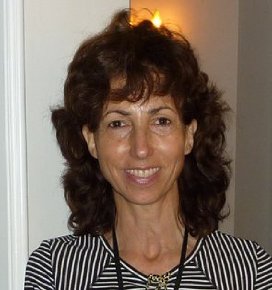
The Family Travel Forum - A
community for those who "Have Kids, Still Travel" and
want to make family vacations more fun, less work and
better value. FTF's travel and parenting features,
including reviews of tropical and ski resorts, reunion
destinations, attractions, holiday weekends, family
festivals, cruises, and all kinds of vacation ideas
should be the first port of call for family vacation
planners. http://www.familytravelforum.com/index.html
ALL YOU NEED BEFORE YOU GO


MARIANI'S VIRTUAL GOURMET
NEWSLETTER is published weekly. Editor/Publisher: John
Mariani.
Contributing Writers: Christopher Mariani, Robert Mariani,
John A. Curtas, Edward Brivio, Mort Hochstein,
Suzanne Wright, and Brian Freedman. Contributing
Photographers: Galina Stepanoff-Dargery,
Bobby Pirillo. Technical Advisor: Gerry McLoughlin.
To un-subscribe from this newsletter,click here.
© copyright John Mariani 2011
